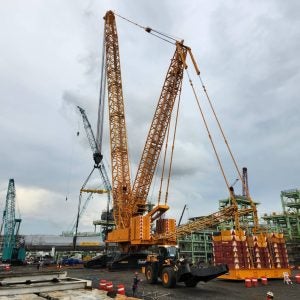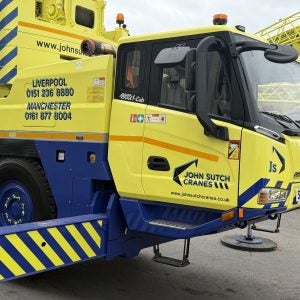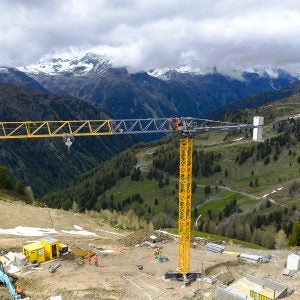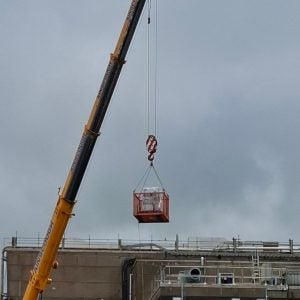Since late 2010, manufacturers have reported an upturn in sales. One of the first crane types to benefit from renewed confidence in the construction industry are rough terrains, as they are used in the earliest stages of any development. Bill Stramer, Link-Belt’s vice president for marketing, sales and customer support, says, “We saw a pick up in rough terrains in the mid-2010. When the market slowed, we worked closely with dealers, so when it came back, we were ready to take advantage of that. We’ve seen continuing rough terrain sales.”
“We’ve seen good growth in our international business. Our product fits very well in the Middle East, and Central and South America. Large rough terrains are very big in Australia.”
At ConExpo, Link-Belt announced two new distributor deals, covering South America through a joint venture based in Chile and Argentina, and in Australia through Ben Baden Services.
Ben Baden says, “We have four Link-Belt rough terrains arriving in April. We’ve ordered one model each of the 30t, 50t, 60t, 80t, 90t, and 120t rough terrains, one 85t truck crane, and one 70t telecrawler. We’ve already sold the telecrawler.
“There’s been a major mining boom in Australia, and there’s demand from LNG plants, coal and gold. There’s big demand for larger rough terrain cranes.
“In Australia, the metropolitan areas are flat, but the mines in Queensland and Western Australia are booming. There are billions of dollars going into infrastructure. Australia is coming to another strong growth phase.”
Terex reported strong sales. The company sold nine all terrains to Netherlands-based Hovago. “In addition to expert support and training, our clients have grown to expect rapid delivery. Our international re-rent program (bare rental to crane rental companies) is becoming increasingly popular due to the extra need of finance capacity with the crane rental companies. The short delivery schedule of our new order is tight and extremely important for our customers,” says Doron Livnat, founder, Hovago.
Terex also sold the first model of its new Roadmaster 9000, to Bay Crane. Kenny Bernardo, president, Bay Crane, says, “As Bay Crane continues to expand its coverage across the Northeast with additional locations in Massachusetts, Rhode Island, Connecticut and New Jersey, this new machine provides us the perfect combination of road-ability, long reach and heavy lift capacity to meet all of our lifting needs in the 90t class.”
Manitowoc announced a number of new orders. All Erection said it had bought two more of the company’s 150USt RT9150E rough terrains, meaning it now owns three of the seven units of the crane in circulation. Michael Liptak, president of the ALL Family of Companies, says, “This crane offers an impressive maximum tip height of 312 ft., features a hydraulic extension, and picks like a beast. The demand is already strong, so much so we have decided to be all in for this product offering.”
Orders weren’t restricted to US businesses. Chinese-owned Sany, a relatively new entrant to the market, reported good sales from its Peachtree, Georgia, based US business. Kyle Nape, vice president, global sales and marketing, Sany America, explains that the company had sold one SCC8300 330USt crawler to Imperial Cranes in Chicago, two more SCC8300s to Deep South in Louisiana, a 220USt SCC8200 to Clark Crane and Rigging in upstate New York, and six 110USt SCC8100s to Four Seasons Equipment in Houston Texas. On the rough terrain side, the company has sold a 60USt SRC860 to Associated Rigging in Syracuse, and a 40USt SRC840 to Clark Crane and Rigging in Buffalo.
Kobelco
Kobelco showed two cranes in its new G series at ConExpo, the 275USt CK2750G and 110USt CK1100G. The new cranes are focused on improving fuel use and emissions, and on upgrades to the operators cab.
The Japanese manufacturer has upgraded its 85-275USt (60-250t) cranes to the new G series.
The new series cranes will be sold with existing ones in the same series until September, when they will replace older cranes fully.
The G series cranes have been fitted with new engines compliant with US EPA Interim Tier IV and Euro Stage IIIB engines, making them suitable for use in markets on both sides of the Atlantic.
With the new series, Kobelco offers a new energy saving assist system, which it says can cut fuel use by up to 30%, compared to previous model. The assist system, known as ‘G-Mode’, includes an auto idle stop system, energy saving winch control system, and engine RPM limitation system.
Some of the biggest changes operators will see are in the cab. The new cab is bigger and more comfortable.
A new single large colour display brings together information on crane condition, the LMI and zone limiter. New controls use short levers, close to the operator.
The new engine has been moved from the right of the superstructure to the left, allowing Kobelco to reduce the width of the machines from 3.2m to less than 3m, making them easier to transport without permits in many jurisdictions.
A new system of vertical cylinders allows for self installation of counterweight. A new hydraulic circuit, offering a choice of single and dual pump flow, makes it possible to use the machines for duty cycle and lifting operations.
Manitex
Manitex showed three 50t cranes on its stand, the 155ft boom 50155S boom truck; the 110ft boom 50110SHL boom truck; and its newest 50-tonner, the 50128S with 128ft boom. The three 50t cranes are each designed to meet different customer demands. With its 155ft (47m) boom the 50155S is the only machine able to reach a 209ft hook height with a single piece jib in permit free operation.
The 50110SHL trades reach for power. While its main boom is shorter than on the 50155S, it is able to offer 360° load charts which, Manitex says, compare favourably with many 60t truck cranes. It can also offer pick and carry capabilities. The newest crane, Manitex says, with its 128ft powered boom and 50t lifting capacity, offers an intermediate reach for general construction.
The newest product on the stand though wasn’t a traditional lift crane, but the new SC130 SkyCrane, designed to act as both a crane and aerial work platform, and aimed at jobs such as sign installation. The latest addition to the SkyCrane range offers a lift height of up to 130ft, making it attractive to HVAC contractors as well as sign installers.
The machine is designed to be easily adopted for lifting or accessing. Even with the access basket attached, the crane can still lift a load. This, Manitex director of sales and marketing Randy Robertson explains, is what makes the crane so attractive to sign installers. When working on the big vinyl advertising hoardings popular in the US, sign installation crew can be lifted to the top of the hoarding using the access basket, and can then use the crane to lift the vinyl sign to the correct height, often without removing the basket. The crane can be controlled using a remote from HBC-radiomatic, or manual controls on the column.
The SC130 was shown mounted on a lightweight 6×4 carrier, with a gross vehicle weight of 56,000lb. The carrier includes plenty of space for payload, up to 10,000lb. The carrier is set up with a number of storage bins, and a trailer hitch to tow up to 10,000lb.
Iowa Mold Tooling
Roughly every five years Iowa Mold Tooling attempts a redesign of its products to keep on top of market developments and ensure they are meeting customer demands.
Despite the fragility of what many see as a gradually recovering US economy, the company has chosen its golden anniversary year to launch a new series of telescopic booms for its truck mounted crane product lines at ConExpo.
IMT’s new telescopic booms will be fitted to updated versions of its Dominator line of mechanics trucks, which have been revamped with improved structural stability to accommodate the new telescopic booms.
IMT claims that this new line of telescopic booms offer some of the longest reaches available in the US service truck market to date, with all cranes in the range from the smallest capacity crane, the 3.75USt 7500, to the highest capacity crane, the 7USt 14000, featuring horizontal boom lengths of over 30ft.
This is facilitated in no small part by the new Pentaboom design featured on the new telescopic crane range.
IMT’s Pentaboom design essentially fuses together the structural loading strength of a rectangular boom while utilising the benefits to boom tracking of a hexagonal crane boom.
IMT product manager for commercial vehicles, Tim Worman, explains: “What has happened in the industry over the last few years is that manufacturers have gone to a six-sided boom, much like an articulated crane you see in Europe.
“All your structural loading is on the top and your tracking is on the bottom, so by having the rectangular tube at the top we dissipate the stresses.
“We don’t have a high stress concentration at the peak at the top of the boom like a hexagonal section, we can spread those loads out. Conversely the bottom side, the hexagonal section, allows us to track truer at 30ft of reach, and additionally allows us to nest it tighter so we don’t have a lot of play in the boom.
“This allows us to mix and match material thickness so we have the material where we need it for the structural loading, and reduce it where we don’t to control our boom weight.”
The Pentaboom’s design was brought about by the firm’s desire to innovate and produce a premium product that could set them apart from the herd.
In the current fiercely competitive US service truck market, made all the more so by the likes of European heavyweight Palfinger entering into the market over the last year, IMT view this as very necessary.
This is despite the US truck crane market experiencing particularly low-level demand, and US construction spending at its lowest levels for a decade.
“It all depends on what happens with housing and construction in general. The market is still unstable as we see fluctuation from month to month. In February we had the worst housing starts number in 27 years.”
However, mirroring the sentiments of many at this year’s show Worman strikes a positive tone, commenting: “In this sector there is still cautious optimism that we’ve bottomed and we’re recovering, but nobody knows to what magnitude. We believe IMT will see growth again this year and moderate growth next year.
“It’s actually the case that a lot of fleets have been depleted over the last two years, they’ve sold off equipment and downsized. I think they are going to be cautious going forward and not get too big, do more with less.
“So they are going to take their time doing that replenishment, but our customers recognise they need equipment to work this year, and they have pent up demand so they’re buying.
“With the commodity and fuel prices as they are the financials still are a concern, so in the last half of the year it’ll be interesting to see what happens, nobody knows right now.
“I don’t think we’ll ever see the buying trends we saw four years ago, that was excessive, but it will recover. It’s not a matter of if: it’s when.”
Manitowoc
Manitowoc used ConExpo to showcase its range of products, including rough terrains, crawlers and all terrains.
On the all terrain side, the company showed two of its new six axle cranes, the Grove GMK6300L and GMK6400. The two cranes were first shown at Bauma in 2010. The 300t (~330USt) GMK6300L has a 262ft (80m) main boom, claimed by Manitowoc to be the longest in its class. Where the 300-tonner is aimed at customers needing the longest reach, the GMK6400 is aimed at customers needing the most lifting power. With a capacity of 400t (450USt) it is, Manitowoc says, the strongest all terrain on six axles.
Also sold under the Grove brand, and claimed to be a record-breaker, is the RT9150E rough terrain. With a lifting capacity of 150USt it is, Manitowoc says, the strongest rough terrain currently in production. In addition to its impressive lifting power, the crane offers a 197ft main boom.
From the Manitowoc crawler range, two cranes were on display. A Model 888, refurbished by H&E Equipment Services through Manitowoc’s new EnCORE programme, was featured in Cranes Today’s news pages last month. The EnCORE programme is designed to help customers reduce the cost of ownership by refurbishing ageing cranes. Manitowoc provides the service through partners such as H&E.
Another crawler, a Model 16000, acted as a landmark for the stand. Manitowoc used the crane to demonstrate two new technologies aimed at the wind turbine erection and maintenance sector. The first of these, a wind attachment, is a very short jib-style attachment which fits to the boom tip, improving the crane’s load chart. The wind attachment was launched in 2010.
The second new technology currently under development for Model 16000 users working in the wind sector is a new boom raising system. Kevin Blaney, Manitowoc product marketing manager for lattice boom crawlers, explains, “The wind attachment was obviously made because the turbines were getting heavier, and the M16000 was, prior to the wind attachment, starting to fall short of the capacity of the new turbines coming out. So that addressed the weight aspect, the capacity aspect of the heavier turbines.
“What it didn’t address was higher turbines. With the wind attachment it tapped out about 85m highest tower height that we could get to. And that related to 92m of boom, that’s the longest combination we can get with the current wind attachment.
“Physically the boom hoist system, the hoist doesn’t have enough power to get longer boom lengths up in the air, it’s just too heavy. So the solution we came up with was adding a hydraulic cylinder to the boom foot section.
“After the boom foot section we’ll add a new section to house our two-stage cylinder, which will lift the entire boom off the ground, until it gets to around 38°–40°, at which point there’s enough weigh up off the ground that the boom hoist can take over and raise it all the way up.”
With the boom raising system installed, Model 16000 users will be able to use longer booms, increasing the maximum main boom from 62m to 107m. While the crane’s capacity will be limited at this maximum height, Manitowoc expects users will find plenty of work performing maintenance on very high wind turbine, and, perhaps, installing some nacelles on the tallest turbines.
Tadano
Tadano showed five new cranes at ConExpo: two new generation rough terrains, the GR-1000XL-2 and GR750XL-2, a new TM-30115 boom truck, and two all terrains. The company also showed a telecrawler from Tadano Mantis.
The new TM-30115 offers, Tadano says, the highest lifting capacity of any 54,000lb boom truck. At 6ft, with eight parts of rope, the crane can lift 60,000lb (27.216t at 1.828m). The crane features a full power synchronised boom measuring 29.5ft when retracted and reaching 115ft when fully extended. A lattice jib offers an extra 27.9ft of reach.
Tadano showed two five axle all terrains, the 160USt capacity ATF 130G-5, and the 250USt ATF 220G-5. The ATF 220G-5 is new to the US market, and was on show in the US for the first time at ConExpo.
The two new rough terrains mark the entry of a new generation of machines to the US market. The GR-1000XL-2 lifts 100USt, and the GR-750XL-2 lifts 75USt. Tadano says that customers, particularly in sectors like mining, are asking for increasingly high capacity rough terrains. Prior to the introduction of the GR-1000XL-2, the biggest rough terrain the company offered was 80USt.
The new GR cranes feature Tadano’s new Hello-Net crane management system. The system allows data from the crane to be shared over GPS and satellite to the crane owner, the manufacturer, and the distributor’s service department, aiding fleet management and maintenance.
Tadano describes the new GR series as the ‘environmentally conscious crane’. The new rough terrains offer two devices to help reduce fuel consumption. ‘Eco mode’ comes into effect when the crane is working. By controlling the maximum engine speed during crane operations, the system cuts CO2 emissions and fuel consumption by as much as 30%. A ‘Positive control system’ works to keep hydraulic pump discharge to a minimum, so that when the crane is not in operation, fuel is not wasted on the pump unnecessarily. This system can cut emissions and fuel use by another 20%.






